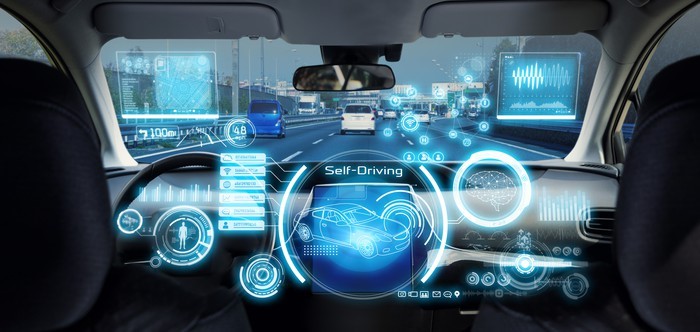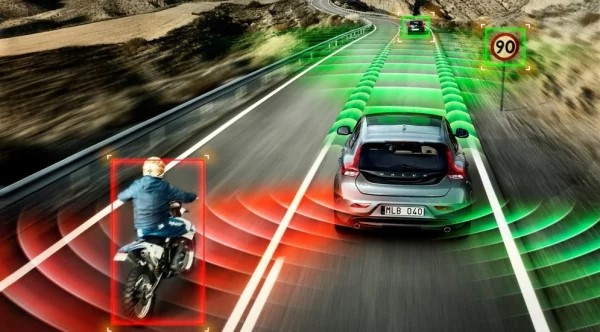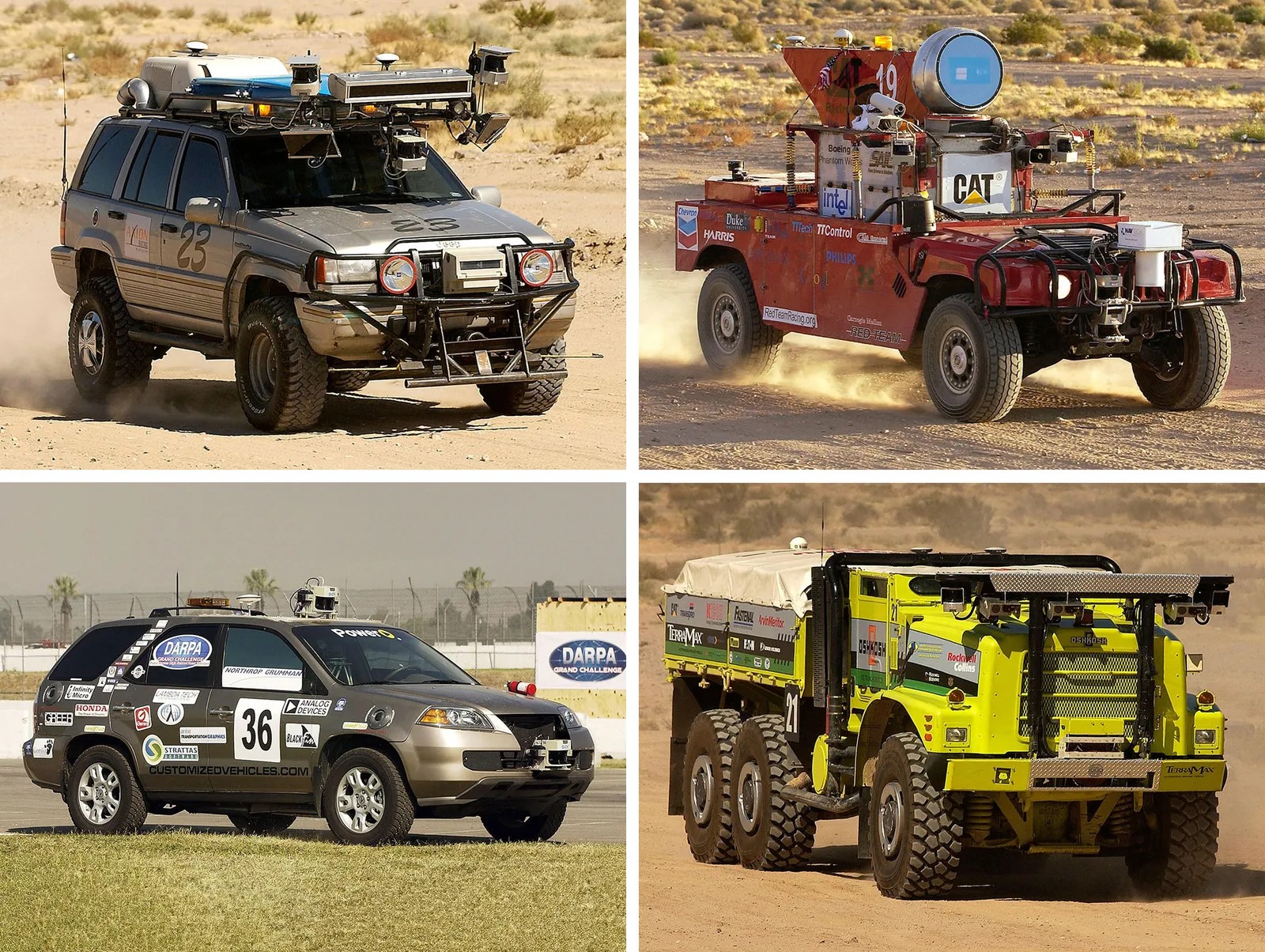
A little over a hundred years ago, the idea of mass-produced automobiles seemed unthinkable, and yet it happened: but scientific and industrial progress continues to accelerate, and today we are already facing a new prospect: the self-driving car. A self-driving car (autonomous vehicle, self-driving car, robot car) is a vehicle that incorporates automotive automation, i.e. a vehicle that can analyse its surroundings and drive unsupervised and without the intervention of those sitting in the vehicle[1]. According to the British newspaper The Guardian, 25% of cars will be self-driving by 2035. According to scientists, the use of robot cars will help reduce accidents by 90% and emissions by 80%[2]. A miracle.
In 1918, an American magazine published an article already launching this development: “… a car with a steering wheel will become as obsolete in the future as a car with a hand pump for petrol or oil today!” and they were not wrong[3]. As early as 1921, in Daytona, Ohio, the RCA presented the first analogue model of a driverless three-wheeled car with wireless control, driven by radio equipment mounted on another vehicle. In 1925, a similar radio-controlled car drove down Fifth Avenue in New York[4].
Since the 1930s, General Motors has been researching the self-driving car industry, the results of which were presented at Futurama World’s Fair. One of the ideas presented was to equip cars with transmitters capable of controlling the distance between vehicles by means of radio waves[5].
In the 1950s, General Motors went from development to the creation of a conceptual model of the Firebird II equipped with magnetic sensors that, according to the engineers’ idea, receive signals from electric cables laid under the roadway. The purpose of this idea is to allow the car, in some cases, to make decisions on manoeuvres and speed limits independently. The vehicle never went into production, but it was the first vehicle to be equipped with what is now widely used in the automotive industry as ‘cruise control’[6].
From science fiction to industrial development

A driver’s dream: a car driven by a series of buttons[7]
Attempts to develop a self-driving vehicle continued, and the real breakthrough came in 1980. The German scientist Ernst Dickmanns, with a team of brilliant engineers, succeeded in creating an intelligent car, based on a Mercedes-Benz semi-trailer, using parallel computing mechanisms, data filtering tools used in navigation systems and the simulation of the rapid movement of the human eye that allows visual scanning of the scene.
The developers invented a vehicle capable of following a certain route and performing manoeuvres[8]. This development attracted the interest of Daimler-Benz and continued within the Eureka project PROMETHEUS (Program for European Traffic with Highest Efficiency and Unprecedented Safety[9], a publicly funded European project[10]) from 1986 to 1995[11], which involved many European developers[12]. By the mid-1990s, Ernst Dickmanns had already created two examples of intelligent cars, VaMP and VITA-2, which in tests were able to drive up to 130 km/h and perform manoeuvres in traffic, such as lane changing and overtaking. These developments have made a significant contribution to technological development and are still widely used in vehicle control automation[13].
Another milestone in the development of self-driving cars was reached by Carnegie Mellon University’s Navlab and ALV project, which started in 1984. In 1995, the Navlab 5 completed an autonomous crossing of the US coastline, covering 98.2% (4501 km out of 4585 km) at an average speed of 102.7 km/h[14]. Since then, the idea of a robot car has firmly entered the plans of automotive giants such as: Mercedes-Benz[15], Bosch[16], Nissan[17], Toyota[18], Audi[19], Vislab of the University of Parma[20] and Google[21].
At the beginning of the 20th century, the US Department of Defense Advanced Research Projects Administration (DARPA) organised the DARPA Grand Challenge, a robot car competition whose goal was to create a fully autonomous vehicle. The competition was funded by the US government. The challenge has been held three times, in 2004, 2005 and 2007[22]. The $1 million prize money in the first competition was not awarded: none of the 15 teams managed to complete the course, but the competition gave a strong impetus to the development of driverless transport and many participants continued their research in this direction. Thus one of them, Chris Urmson, became one of Google’s leading car developers and entered the industry with his company, Aurora[23]. Several American states, such as Nevada, Florida, California, Virginia and Michigan, gave permission in 2015 to test automated cars on public roads[24].
Principles of operation

Display of sensor operation[25]
The main task of a self-driving car is to drive a given route without the involvement of the driver, so the car ‘has’ to see like a human being, analyse the information received, make quick decisions and know the route. Navigation systems and sensors are used to determine the exact position of the car and to optimise route planning, with up-to-date information on traffic conditions and the speed allowed on different stretches of road[26]. Sensors play a very important role, as vehicle actions are based on the information gathered.
It is usually installed as[27]:
- Lidar – a laser with 360° rotation, capable of clearly detecting objects close to the vehicle and determining their distance[28];
- Radar – radar systems that detect objects and are able to determine their distance, speed and geometric parameters[29];
- Cameras – detect traffic lights, road signs[30] and support radar systems for pedestrians and cyclists[31];
- Global Positioning Systems – a satellite navigation system[32].
In addition, unmanned vehicles can be equipped with microphones that detect the sound of an emergency siren[33].
The information collected by all the sensors is transmitted to the control computer, which, after analysing the data collected, makes basic decisions on the vehicle’s behaviour on the road[34]. Algorithms are used to process the collected environmental data and make predictions, such as the speed at which objects move relative to one another[35]. This data forms the basis for further vehicle actions, which are executed by the steering controller. This, in turn, activates commands to manoeuvre the vehicle, change speed, brake, et cetera[36].
Put simply, a driverless car works like this: the vehicle drives on the road, the lidar scans the surrounding terrain in real time and transmits the information to the control computer, which processes and maps it. Manufacturers of self-driving cars often prefer satellite communications to the Internet. Data from other sensors are processed by algorithms to simulate the current situation on the road, assess the behaviour of other road users, predict the robot car’s movement and its next steps (change of speed or manoeuvre)[37].

Participants of the DARPA Grand Challenge 2004[38]
SAE International, the US Society of Automotive Engineers, has established six levels of vehicle automation:
Level 0 – no automation, the driver is completely responsible for the dynamic driving process. Many vehicles equipped with driver assistance functions, such as the anti-lock brake system, are not considered automated because these functions do not perform the task of dynamic driving on a continuous basis[39];
Level 1 – partial driver assistance in the form of acceleration, deceleration or steering; this level includes vehicles equipped with cruise control, adaptive cruise control, parking assistance, automatic emergency braking[40];
Level 2 – partial automation. Driver assistance systems that may allow ‘hands-free’ driving under certain circumstances assist with acceleration/deceleration and steering, but the driver must assume instant control if necessary. This is not an ‘autopilot’, but rather an enhanced driver assistance system[41];
Level 3 – conditioned automation. This level should allow the driver to remain in ‘standby’ while the system handles traffic within its ‘development work area’[42]. The driver should be ready to regain control within the time specified by the manufacturer. This level can be described as ‘co-pilot’[43]. The difference between level 2 and level 3 is essentially the time in which the driver must regain control of the vehicle[44].
Level 4 – high level of autonomy, autopilot. As long as the system operates in a ‘development workspace’, it does not require human intervention. The operation of this level depends directly on highly detailed 3D maps[45].
Level 5 – full automation. Unlimited automatic driving, the vehicle is able to drive autonomously, without human intervention, over any terrain where an experienced driver can pass[46].
Advantages, disadvantages and risks

He sleeps while Tesla autopilot drives on the motorway: Johnathon Cook’s crazy gesture for a video on social media[47]
The principle is clear: a robot car does not get tired, does not fall asleep, is not emotional, does not abuse alcohol or drugs, scrupulously observes traffic rules and speed limits, does not get distracted while driving, and in general: robots make mistakes far less often than people. The elimination of the human factor from the road situation contributes to a significant reduction in road accidents, which is the main and most important benefit of the mass use of a self-driving car[48]. Furthermore, the significant reduction in accidents involving humans can drastically reduce the costs of health insurance and emergency medicine[49].
The mass use of self-driving cars will have an impact on the logistics industry: the transport of goods and people will become cheaper due to savings in fuel and driver salaries, and the transport process will take less time because the robot is not limited by working hours. It will also be possible to deliver goods in difficult weather conditions, natural disasters and even military operations[50].
The expansion of the robotics segment will reduce the need for private cars, which, in the long run, will lead to a reduction in exhaust emissions and, consequently, to an improvement in the climate[51]. The social advantage of robot transport is its universal accessibility. The robot car can be used by everyone, regardless of physical characteristics or driving licence. Passengers can optimise their time and devote themselves to necessary work or leisure activities during the journey[52]. Furthermore, the efficiency of road use will be improved by the vehicle’s full compliance with road traffic regulations.
However, the idea of fully automated driving also has a number of disadvantages: if self-driving cars were to be used en masse, there would be significant changes in the labour market, because professions such as chauffeur, truck driver, taxi driver and delivery man [53]would no longer be in demand. Goldman Sachs, one of the world’s largest investment banks, has calculated that the robotization of road transport will lead to the loss of 300,000 jobs per year in the transport sector[54].
Another point is that privacy is compromised in the case of the use of robotized vehicles, since the very essence of the system is the collection and processing of private data: from the route to the information flows used inside the vehicle (such as voice recordings, cameras, media used). In the specific case of a cyber attack, it compromises the personal data of passengers, but in the context of national security, the loss of data or the hacking of the control system of an autonomous vehicle could lead to total espionage[55].

Firebird III, Century 21st Exposition, Seattle 1962[56]
From a legal point of view, the question remains: who is liable in the event of an accident with a self-driving vehicle? The boundaries of manufacturer and user liability should be regulated by law before robot cars arrive on the roads en masse. The same applies to insurance, as no major insurance company in Europe or the US has yet commented on the principles according to which insurance risks should be calculated[57].
When discussing the pros and cons of drone transport, the moral dilemma of driverless cars is probably the most acute. A robot car is guided by algorithms when making decisions: based on input data it makes a decision known to the system, but what if the choice has to be made in favour of the ‘least worst’ option? [58]
Suppose that, in an emergency, an autonomous vehicle has to choose between colliding with a school bus or a pole. If there are no other options, the car must decide whether to save the driver or the passengers of the school bus. It is ethically unacceptable to let the car decide whether to save or take a life[59]. For this reason, any vehicle needs the driver’s hands on the wheel and his decisions in an emergency situation[60]. But this requires the driver to have driving skills and experience, which is, in my opinion, unlikely if a self-driving car can be used by anyone, without learning and experience, regardless of health conditions.
In an attempt to make autonomous vehicles ethical and to create a ‘universal moral code’, an international team of researchers from different fields created the ‘Moral Machine’ project in 2015[61]. The aim is to collect information on how users think an unmanned vehicle should behave in a simulated critical situation. In 2018, the British edition of Nature published data on how 40 million respondents from more than 223 countries took the test[62]. Moral Machine’s analysis of the test results showed that ethical standards vary from country to country, and from region to region[63].

An example of a question from the Moral Machine test[64]
Despite their safety advantages, automated vehicles are still involved in accidents. In the US, two cases of accidents involving automated vehicles have been reported, some of them fatal. The ‘leader’ in the number of accidents related to driver assistance technologies was the manufacturer Tesla, while Waymo has the highest number of accidents involving autonomous vehicles[65]. As of 2021, the US National Highway Traffic Safety Administration (NHTSA) has required all car manufacturers to immediately report all accidents and incidents involving automated vehicles from automation level 2 onwards[66]. The results have not yet been published.
The industries involved

General Motors’ Origin seats six passengers and has no steering wheel: production start in 2023[67]
At the end of 2021, the leading positions in the driverless vehicle market are distributed as follows: General Motors (USA), Ford (USA), Daimler (Germany), Volkswagen (Germany), Toyota (Japan) and Waymo (USA)[68]. According to ResearchAndMarkets, the global market for self-driving cars is 20.3 million units in 2021[69]. In general, the automotive industry is changing and manufacturers are offering an increasing number of functions to simplify the driver’s task. For example: Honda and Toyota are introducing blind spot detection, automatic emergency braking, forward collision warning and rear cross-traffic alert, as well as lane keeping assistance as standard features of their products. The demand for high levels of safety and driving comfort is a major motivation for the development of the driverless car market[70].
Guidehouse Insights’ 2021 report[71] compares 15 companies involved in the development and implementation of control systems for small and medium-sized unmanned vehicles[72]. The evaluation is based on ten criteria: objectives, entry strategies, partners, technology, product capabilities, sales and marketing, quality and reliability, product range and profitability[73]. According to the results, the performance ranking is as follows: in first place we find Waymo (US, subsidiary of Alphabet Inc., in charge of the development of the Google Group’s Google Driverless Car project)[74]; in second place is Nvidia (US, technology company, developer of on-board computers for the self-driving car transport sector)[75]; then follows Argo AI (US, remote driving technology company)[76]; and Baidu (China, technology company specialising in the development of artificial intelligence)[77] concludes the podium.
Expectations and reality

October 2020: PBS documentary ‘Look Who’s Driving’ illustrates the innovations and challenges of achieving level 5 autonomy for cars[78]
With the emergence of the mass development of self-driving vehicles, the competition in this segment has changed direction significantly from a technological perspective. The automotive giants are increasingly joining forces with industry leaders in the development of autonomous driving systems[79].
The idea of mass deployment of self-driving cars challenges both the technological and legal worlds[80], investments have long since crossed the billion-dollar threshold, and manufacturers’ announcements about the mass introduction of a truly autonomous car on public roads remain astonishing promises[81]. The American car manufacturer Tesla released a beta version of its car software labelled ‘Fully Self-Driving’ in 2020, but in reality this system corresponded to level 2 of automation[82].
Today, the highest level of automated driving available on the market requires the full attention and involvement of the driver[83]. As of 1 January 2023, California prohibits Tesla (which has long promised the self-driving car[84], despite requiring ‘active driver supervision and not making the vehicle autonomous’ [85]) and other manufacturers from calling vehicles with advanced assistance systems ‘full self-driving’ and accuses them of false advertising[86]. However, this does not stop manufacturers; on the contrary, it encourages them to create new designs and prototypes and to announce long-term forecasts. At least three automotive giants (Toyota[87], Honda[88], General Motors[89]) have announced the immediate testing of intelligent transport systems conforming to SAE Level 4 automation.
Road tests are in full swing. Thus, in the United States, with the permission of the NHTSA, General Motors is testing its pilot programmes with the driverless taxi project Cruise[90], Waymo[91], and the joint investment project of Ford and Volkswagen – Argo AI[92]. The driving of these prototypes is subject to certain conditions[93].
The legislative framework of the European Union is changing: new EU vehicle safety regulations[94] govern the introduction of a number of mandatory driver assistance systems. These regulations are the legal anchor for the approval of automated and fully automated vehicles as fully-fledged road users[95].
The robotisation train is moving full speed ahead, but, in my opinion, everything still looks like an unassembled jigsaw puzzle, and it will be years before mass use of self-driving vehicles is achieved. The results of the Moral Machine test confirm that the creation of a universal ‘moral code’ for robotic vehicles will be very difficult[96]. For now, therefore, fully robotic cars are still the technology of the future[97]. But a future we can almost touch with our hands.
[1] https://www.tadviser.ru/index.php/%D0%A1%D1%82%D0%B0%D1%82%D1%8C%D1%8F:%D0%90%D0%B2%D1%82%D0%BE%D0%BF%D0%B8%D0%BB%D0%BE%D1%82_(%D0%B1%D0%B5%D1%81%D0%BF%D0%B8%D0%BB%D0%BE%D1%82%D0%BD%D1%8B%D0%B9_%D0%B0%D0%B2%D1%82%D0%BE%D0%BC%D0%BE%D0%B1%D0%B8%D0%BB%D1%8C)
[2] https://blog.eldorado.ru/publications/kak-ustroeny-bespilotnye-avtomobili-vse-chto-nuzhno-znat-o-glavnoy-tekhnologii-budushchego-24354
[3] https://habr.com/ru/company/itelma/blog/505872/
[4] https://habr.com/ru/company/itelma/blog/505872/
[5] https://habr.com/ru/company/itelma/blog/505872/
[6] https://www.svyaznoy.ru/reviews/text_istoriya_bespilotnyh_avtomobiley
[7] https://habr.com/ru/company/itelma/blog/505872/
[8] https://www.svyaznoy.ru/reviews/text_istoriya_bespilotnyh_avtomobiley
[9] https://trashbox.ru/topics/94912/chto-takoe-bespilotnye-avtomobili-istoriya-principy-raboty-buduschee
[10] https://habr.com/ru/company/itelma/blog/505872/
[11] https://web.archive.org/web/20180814201633/http://www.eurekanetwork.org/project/id/45
[12] https://habr.com/ru/company/itelma/blog/505872/
[13] https://trashbox.ru/topics/94912/chto-takoe-bespilotnye-avtomobili-istoriya-principy-raboty-buduschee
[14] https://www.cs.cmu.edu/afs/cs/usr/tjochem/www/nhaa/Journal.html
[15] https://people.idsia.ch/~juergen/robotcars.html
[16] https://spectrum.ieee.org/video-friday-875243152
[17] https://www.bbc.com/news/technology-19829906
[18] https://www.bbc.com/news/technology-20910769
[19] https://web.archive.org/web/20120710202052/http://www.audiusa.com/us/brand/en/tools/news/pool/2010/07/new_look__reaffirmed.html
[20] https://web.archive.org/web/20131114073738/http://www.mnn.com/green-tech/transportation/stories/8000-mile-driverless-test-drive-begins ; https://web.archive.org/web/20210224011835/http://manonthemove.com/2010/07/21/vislab-intercontinental-autonomous-challenge-inaugural-ceremony-milan-italy/
[21] https://www.theatlantic.com/technology/archive/2012/08/googles-self-driving-cars-300-000-miles-logged-not-a-single-accident-under-computer-control/260926/
[22] https://www.darpa.mil/news-events/2014-03-13
[23] https://ir.aurora.tech/company-information/leadership-team
[24] https://richmond.com/news/article_b1168b67-3b2b-5274-8914-8a3304f2e417.html
[25] https://trashbox.ru/topics/94912/chto-takoe-bespilotnye-avtomobili-istoriya-principy-raboty-buduschee
[26] https://trashbox.ru/topics/94912/chto-takoe-bespilotnye-avtomobili-istoriya-principy-raboty-buduschee
[27] https://habr.com/ru/post/396185/
[28] https://www.rolf.ru/blog/bespilotnye_avtomobili__principy_raboty__plusy_i_minusy/
[29] https://dic.academic.ru/dic.nsf/ruwiki/1114235
[30] https://www.iotworlds.com/ru/%d0%ba%d0%b0%d0%ba-%d1%80%d0%b0%d0%b1%d0%be%d1%82%d0%b0%d1%8e%d1%82-%d0%b0%d0%bb%d0%b3%d0%be%d1%80%d0%b8%d1%82%d0%bc%d1%8b-%d1%81%d0%b0%d0%bc%d0%be%d1%83%d0%bf%d1%80%d0%b0%d0%b2%d0%bb%d1%8f%d0%b5/
[31] https://www.tadviser.ru/index.php/%D0%A1%D1%82%D0%B0%D1%82%D1%8C%D1%8F:%D0%90%D0%B2%D1%82%D0%BE%D0%BF%D0%B8%D0%BB%D0%BE%D1%82_(%D0%B1%D0%B5%D1%81%D0%BF%D0%B8%D0%BB%D0%BE%D1%82%D0%BD%D1%8B%D0%B9_%D0%B0%D0%B2%D1%82%D0%BE%D0%BC%D0%BE%D0%B1%D0%B8%D0%BB%D1%8C)
[33] https://www.rolf.ru/blog/bespilotnye_avtomobili__principy_raboty__plusy_i_minusy/
[34] https://blog.eldorado.ru/publications/kak-ustroeny-bespilotnye-avtomobili-vse-chto-nuzhno-znat-o-glavnoy-tekhnologii-budushchego-24354
[35] https://www.iotworlds.com/ru/%D0%BA%D0%B0%D0%BA-%D1%80%D0%B0%D0%B1%D0%BE%D1%82%D0%B0%D1%8E%D1%82-%D0%B0%D0%BB%D0%B3%D0%BE%D1%80%D0%B8%D1%82%D0%BC%D1%8B-%D1%81%D0%B0%D0%BC%D0%BE%D1%83%D0%BF%D1%80%D0%B0%D0%B2%D0%BB%D1%8F%D0%B5/
[36] https://blog.eldorado.ru/publications/kak-ustroeny-bespilotnye-avtomobili-vse-chto-nuzhno-znat-o-glavnoy-tekhnologii-budushchego-24354
[37] https://blog.eldorado.ru/publications/kak-ustroeny-bespilotnye-avtomobili-vse-chto-nuzhno-znat-o-glavnoy-tekhnologii-budushchego-24354
[38] https://www.wired.com/story/darpa-grand-challenge-2004-oral-history/
[39] https://www.wired.com/story/darpa-grand-challenge-2004-oral-history/
[40] https://vc.ru/transport/48947-bespilotnye-avtomobili-obyasnenie-6-urovney-avtonomnosti
[41] https://vc.ru/transport/48947-bespilotnye-avtomobili-obyasnenie-6-urovney-avtonomnosti
[42] https://vc.ru/transport/48947-bespilotnye-avtomobili-obyasnenie-6-urovney-avtonomnosti
[43] https://www.autopilotreview.com/self-driving-cars-sae-levels/
[44] https://vc.ru/transport/48947-bespilotnye-avtomobili-obyasnenie-6-urovney-avtonomnosti
[45] https://www.tadviser.ru/index.php/%D0%A1%D1%82%D0%B0%D1%82%D1%8C%D1%8F:%D0%90%D0%B2%D1%82%D0%BE%D0%BF%D0%B8%D0%BB%D0%BE%D1%82_(%D0%B1%D0%B5%D1%81%D0%BF%D0%B8%D0%BB%D0%BE%D1%82%D0%BD%D1%8B%D0%B9_%D0%B0%D0%B2%D1%82%D0%BE%D0%BC%D0%BE%D0%B1%D0%B8%D0%BB%D1%8C)
[46] https://www.autopilotreview.com/self-driving-cars-sae-levels/
[47] https://www.motorionline.com/dorme-tesla-model-3-autopilot-video-johanathon-cook-tiktok/
[48] https://environmental-conscience.com/self-driving-cars-pros-cons/
[49] https://b-mag.ru/bespilotnyj-transport-dlja-ljudej-pljusy-i-minusy-samoupravljaemyh-avtomobilej/
[50] https://www.tadviser.ru/index.php/%D0%A1%D1%82%D0%B0%D1%82%D1%8C%D1%8F:%D0%90%D0%B2%D1%82%D0%BE%D0%BF%D0%B8%D0%BB%D0%BE%D1%82_(%D0%B1%D0%B5%D1%81%D0%BF%D0%B8%D0%BB%D0%BE%D1%82%D0%BD%D1%8B%D0%B9_%D0%B0%D0%B2%D1%82%D0%BE%D0%BC%D0%BE%D0%B1%D0%B8%D0%BB%D1%8C)
[51] http://vestnik-glonass.ru/news/intro/ekologicheskie-plyusy-i-minusy-bespilotnykh-avtomobiley/
[52] https://www.rolf.ru/blog/bespilotnye_avtomobili__principy_raboty__plusy_i_minusy/
[53] http://vestnik-glonass.ru/news/intro/ekologicheskie-plyusy-i-minusy-bespilotnykh-avtomobiley/
[54] https://negrettilaw.com/news/self-driving-cars-pros-and-cons/
[55] https://www.csis.org/analysis/national-security-implications-leadership-autonomous-vehicles
[56] https://habr.com/ru/company/itelma/blog/505872/
[57] https://www.partner-inform.de/partner/detail/2017/2/159/8381/samoupravljaemye-avtomobili?lang=ru
[58] https://negrettilaw.com/news/self-driving-cars-pros-and-cons/
[59] https://environmental-conscience.com/self-driving-cars-pros-cons/
[60] https://thecode.media/self-drive/
[61] https://www.moralmachine.net/hl/ru ; https://www.techinsider.ru/technologies/760863-etika-bespilotnikov-kak-nelzya-kodirovat-moral/
[62] https://www.techinsider.ru/technologies/760863-etika-bespilotnikov-kak-nelzya-kodirovat-moral/
[63] https://elementy.ru/novosti_nauki/433355/Moralnye_problemy_bespilotnykh_avtomobiley_ne_imeyut_universalnogo_resheniya
[64] https://www.techinsider.ru/technologies/760863-etika-bespilotnikov-kak-nelzya-kodirovat-moral/
[65] https://itc.ua/news/regulyator-ssha-vypustil-otchet-po-dtp-s-samoupravlyaemymi-avtomobilyami-v-liderah-tesla-i-waymo/
[66] https://itc.ua/news/regulyator-ssha-vypustil-otchet-po-dtp-s-samoupravlyaemymi-avtomobilyami-v-liderah-tesla-i-waymo/
[67] https://www.nytimes.com/2020/01/22/technology/cruise-gm-self-driving-car.html ; https://www.cnbc.com/2021/05/13/gm-to-begin-production-of-new-driverless-cruise-vehicle-in-early-2023.html
[68] https://www.tadviser.ru/index.php/%D0%A1%D1%82%D0%B0%D1%82%D1%8C%D1%8F:%D0%91%D0%B5%D1%81%D0%BF%D0%B8%D0%BB%D0%BE%D1%82%D0%BD%D1%8B%D0%B5_%D0%B0%D0%B2%D1%82%D0%BE%D0%BC%D0%BE%D0%B1%D0%B8%D0%BB%D0%B8_(%D0%BC%D0%B8%D1%80%D0%BE%D0%B2%D0%BE%D0%B9_%D1%80%D1%8B%D0%BD%D0%BE%D0%BA)#2021:_.D0.9C.D0.B8.D1.80.D0.BE.D0.B2.D0.BE.D0.B9_.D1.80.D1.8B.D0.BD.D0.BE.D0.BA_.D0.B1.D0.B5.D1.81.D0.BF.D0.B8.D0.BB.D0.BE.D1.82.D0.BD.D1.8B.D1.85_.D0.B0.D0.B2.D1.82.D0.BE_.D0.BE.D1.86.D0.B5.D0.BD.D0.B5.D0.BD_.D0.B2_20.2C3_.D0.BC.D0.BB.D0.BD_.D1.88.D1.82.D1.83.D0.BA
[69] https://www.tadviser.ru/index.php/%D0%A1%D1%82%D0%B0%D1%82%D1%8C%D1%8F:%D0%91%D0%B5%D1%81%D0%BF%D0%B8%D0%BB%D0%BE%D1%82%D0%BD%D1%8B%D0%B5_%D0%B0%D0%B2%D1%82%D0%BE%D0%BC%D0%BE%D0%B1%D0%B8%D0%BB%D0%B8_(%D0%BC%D0%B8%D1%80%D0%BE%D0%B2%D0%BE%D0%B9_%D1%80%D1%8B%D0%BD%D0%BE%D0%BA)#2021:_.D0.9C.D0.B8.D1.80.D0.BE.D0.B2.D0.BE.D0.B9_.D1.80.D1.8B.D0.BD.D0.BE.D0.BA_.D0.B1.D0.B5.D1.81.D0.BF.D0.B8.D0.BB.D0.BE.D1.82.D0.BD.D1.8B.D1.85_.D0.B0.D0.B2.D1.82.D0.BE_.D0.BE.D1.86.D0.B5.D0.BD.D0.B5.D0.BD_.D0.B2_20.2C3_.D0.BC.D0.BB.D0.BD_.D1.88.D1.82.D1.83.D0.BA
[70] https://www.tadviser.ru/index.php/%D0%A1%D1%82%D0%B0%D1%82%D1%8C%D1%8F:%D0%91%D0%B5%D1%81%D0%BF%D0%B8%D0%BB%D0%BE%D1%82%D0%BD%D1%8B%D0%B5_%D0%B0%D0%B2%D1%82%D0%BE%D0%BC%D0%BE%D0%B1%D0%B8%D0%BB%D0%B8_(%D0%BC%D0%B8%D1%80%D0%BE%D0%B2%D0%BE%D0%B9_%D1%80%D1%8B%D0%BD%D0%BE%D0%BA)#2021:_.D0.9C.D0.B8.D1.80.D0.BE.D0.B2.D0.BE.D0.B9_.D1.80.D1.8B.D0.BD.D0.BE.D0.BA_.D0.B1.D0.B5.D1.81.D0.BF.D0.B8.D0.BB.D0.BE.D1.82.D0.BD.D1.8B.D1.85_.D0.B0.D0.B2.D1.82.D0.BE_.D0.BE.D1.86.D0.B5.D0.BD.D0.B5.D0.BD_.D0.B2_20.2C3_.D0.BC.D0.BB.D0.BD_.D1.88.D1.82.D1.83.D0.BA
[71] https://guidehouseinsights.com/news-and-views/navigant-research-is-now-guidehouse-insights
[72] https://guidehouseinsights.com/reports/guidehouse-insights-leaderboard-automated-driving-systems
[73] https://www.imena.ua/blog/18-companies-to-get-driverless-cars/
[75] https://www.nvidia.com/de-de/
[78] https://www.roboticsbusinessreview.com/unmanned/unmanned-ground/pbs-science-show-nova-shines-its-spotlight-on-self-driving-cars/
[79] https://guidehouseinsights.com/reports/guidehouse-insights-leaderboard-automated-driving-systems
[80] https://www.tadviser.ru/index.php/%D0%A1%D1%82%D0%B0%D1%82%D1%8C%D1%8F:%D0%90%D0%B2%D1%82%D0%BE%D0%BF%D0%B8%D0%BB%D0%BE%D1%82_(%D0%B1%D0%B5%D1%81%D0%BF%D0%B8%D0%BB%D0%BE%D1%82%D0%BD%D1%8B%D0%B9_%D0%B0%D0%B2%D1%82%D0%BE%D0%BC%D0%BE%D0%B1%D0%B8%D0%BB%D1%8C)
[81] https://nplus1.ru/material/2022/10/31/robotaxi-arriving
[82] https://www.thedrive.com/tech/39647/tesla-admits-current-full-self-driving-beta-will-always-be-a-level-2-system-emails
[83] https://www.nhtsa.gov/technology-innovation/automated-vehicles-safety
[84] https://edition.cnn.com/2022/12/12/business/tesla-fsd-autopilot-lawsuit/index.html
[85] https://www.gazzetta.it/motori/mobilita-sostenibile/auto-elettriche/25-11-2022/elon-musk-annuncio-guida-autonoma-completa-full-self-driving.shtml
[86] https://www.gazzetta.it/motori/la-mia-auto/29-12-2022/tesla-autopilot-la-california-vieta-a-tutti-di-chiamarlo-guida-autonoma.shtml
[87] https://global.toyota/en/newsroom/corporate/30344967.html
[88] https://www.honda.co.jp/topics/2022/ct_2022-09-29.html
[89] https://www.reuters.com/business/autos-transportation/gm-seeks-us-approval-deploy-self-driving-vehicle-2022-02-18/
[91] https://waymo.com/waymo-one/
[92] https://www.tadviser.ru/index.php/%D0%9A%D0%BE%D0%BC%D0%BF%D0%B0%D0%BD%D0%B8%D1%8F:Argo_AI#.D0.9F.D0.BE_.D1.83.D0.BB.D0.B8.D1.86.D0.B0.D0.BC_.D0.9C.D0.B0.D0.B9.D0.B0.D0.BC.D0.B8_.D0.B8_.D0.9E.D1.81.D1.82.D0.B8.D0.BD.D0.B0_.D0.BD.D0.B0.D1.87.D0.B0.D0.BB.D0.B8_.D0.B5.D0.B7.D0.B4.D0.B8.D1.82.D1.8C_.D0.B0.D0.B2.D1.82.D0.BE.D0.BC.D0.BE.D0.B1.D0.B8.D0.BB.D0.B8_.D0.B1.D0.B5.D0.B7_.D0.B2.D0.BE.D0.B4.D0.B8.D1.82.D0.B5.D0.BB.D0.B5.D0.B9
[93] https://www.nhtsa.gov/technology-innovation/automated-vehicles-safety
[94] https://eur-lex.europa.eu/legal-content/EN/ALL/?uri=CELEX:32019R2144
[95] https://ec.europa.eu/commission/presscorner/detail/en/IP_22_4312
[96] https://elementy.ru/novosti_nauki/433355/Moralnye_problemy_bespilotnykh_avtomobiley_ne_imeyut_universalnogo_resheniya
[97] https://www.nhtsa.gov/technology-innovation/automated-vehicles-safety
Leave a Reply